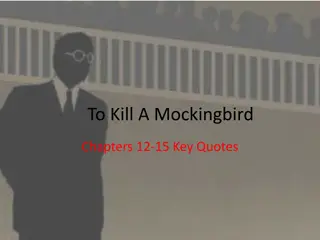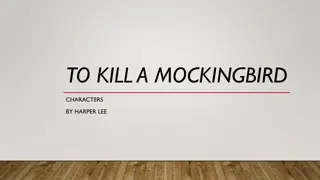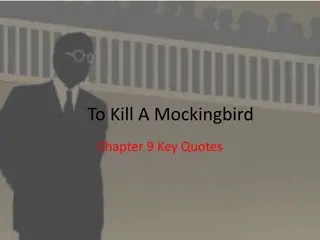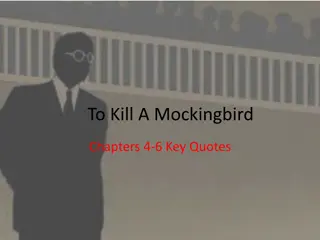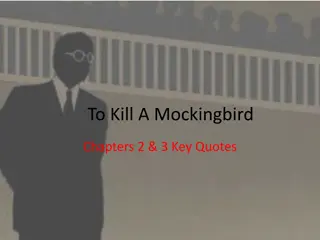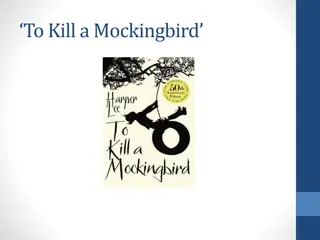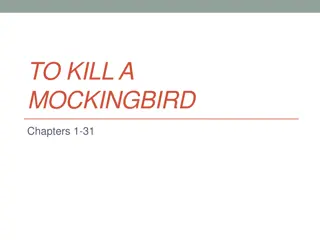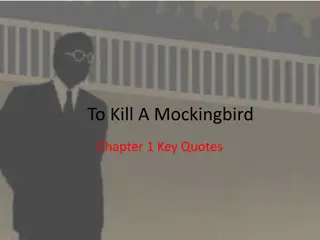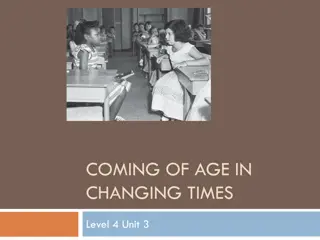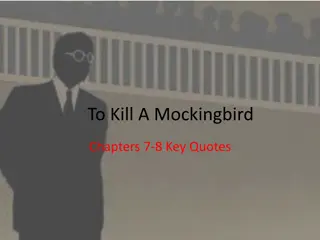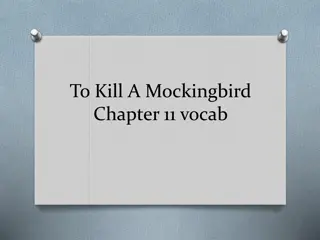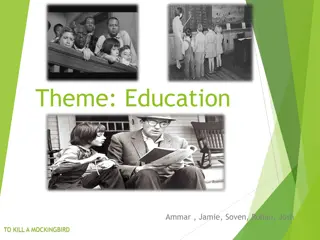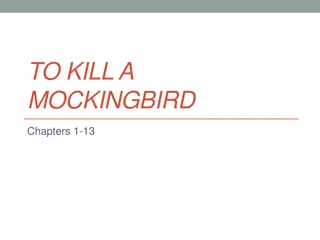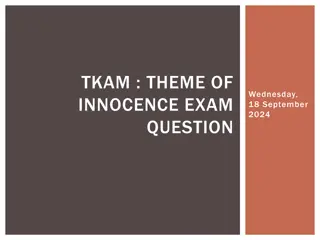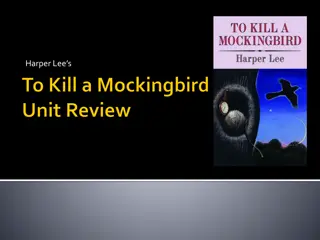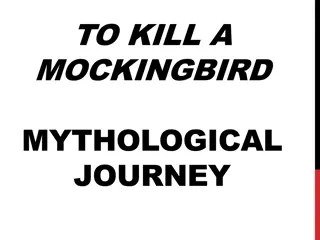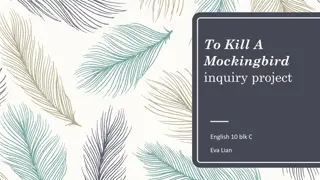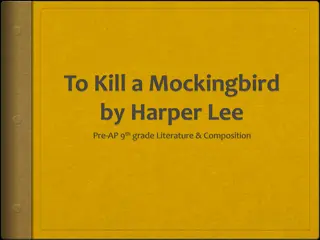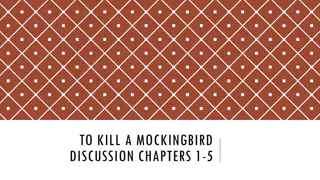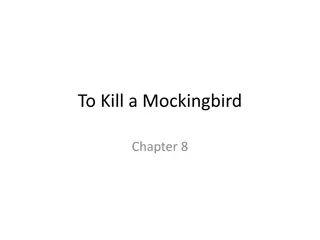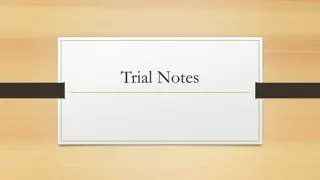Insights into Harper Lee's "To Kill a Mockingbird
Delve into the intricacies of "To Kill a Mockingbird" by exploring the vivid settings, complex characters, societal dynamics, and moral dilemmas depicted in various chapters of the book. Uncover the themes of prejudice, empathy, justice, and morality as you navigate through the vivid descriptions and thought-provoking events crafted by Harper Lee.
Download Presentation

Please find below an Image/Link to download the presentation.
The content on the website is provided AS IS for your information and personal use only. It may not be sold, licensed, or shared on other websites without obtaining consent from the author. Download presentation by click this link. If you encounter any issues during the download, it is possible that the publisher has removed the file from their server.
E N D
Presentation Transcript
Chapter 1 Describe the setting so far. Include everything you think is relevant. Be sure to include a description of the Radley house and surrounding yard.
Chapters 2 and 3 1. Describe Scout s character. 2. Describe the Cunninghams. 3. Why does Walter pour syrup on everything and why does Atticus get angry at Scout for noticing? 4. Describe the Ewells. 5. Contrast the Cunninghams and the Ewells. 6. What sort of man is Atticus Finch? 7. What impression do we get of school from this novel? What does Scout s unpleasant first day tell us about Maycomb s social order? What can we infer about the author s attitudes towards children and education?
Chapters 4 - 6 1. What do the presents indicate about Boo? 2. What do the children s reactions to the presents tell us about the society they live in? 3. Describe how Boo must have felt seeing the enactment of his past and the scissors every day. 4. When Scout rolled inside the Radley s gate, she heard laughing. What does this tell about what Boo was really like? 5. Why do you think Harper Lee worked so hard in these chapters to keep the reader interested in Boo Radley? What might his relevance be in the main plot?
Chapters 7 - 9 1. Why does Mr. Radley cement up the tree? What does this tell about his character? 2. Harper Lee never tells us that it is Boo Radley who mended Jem s pants or put the gifts in the tree, but we can infer that it was, in fact, him. In your opinion, why didn t she just tell us? 3. Explain the two major events that occur in chapter 8. 4. Why is Atticus defending Tom? 5. Should he take on this case? Why or why not?
Chapters 10 and 11 1. What does the mad dog incident show about Atticus? 2. How does Jem s opinion of his father change in chapter 10? 3. What does it mean to say that it s a sin to kill a mockingbird? 4. Describe Mrs. Henry Lafayette Dubose.
Chapters 12 - 14 1. Why will no one hire Tom s wife? 2. How are girls treated differently than boys during this time period? Why do you think this is so? 3. What is the other side of Calpurnia, as witnessed by Scout at church? Why are both sides necessary for Calpurnia? 4. Is Aunt Alexandria racist? Support your answer. 5. Provide a description of the contrasting parenting styles of Aunt Alexandra and Atticus. Use examples from the story. Which, in your opinion, would likely be the most effective style. Why?
Chapters 15 - 17 1. Why did Mr. Cunningham retreat? 2. What did Scout do and does her presence change the situation? Some criticize this event as being highly unbelievable and unconvincing. Thinking about these actions in the context of the setting and characters, do you agree or disagree? Explain. 3. How do people react in the mob? Would they react differently on their own? Why or why not? 4. Bob Ewell s character can be compared to another important character we encountered in Arthur Miller s The Crucible. Determine which character, and explain how the comparison can be made.
Chapters 18 - 20 1. What do you believe really happened at the Ewell residence the night that Mayella was allegedly raped by Tom Robinson. 2. Describe the life that Mayella Ewell lived. 3. Can Mayella Ewell s character be likened to the mockingbird? Why or Why not? 4. Tom Robinson s fatal flaw may have been his true morality and goodness, and his ability to feel pity for others, regardless of race, gender, or social standing. In your opinion, is Tom a tragic hero? 5. Who is Dolphus Raymond and why does he act the way he does?
Chapters 21 - 23 1. What is the significance of Jem and Scout sitting in the gallery? 2. Is Boo a prisoner or a refugee? Explain. 3. Describe the Cunninghams.
Chapters 24 - 26 1. Define the term hypocrisy. 2. Discuss the hypocrisy of the missionary tea party. 3. Why did Tom go mad in the prison? 4. How does the white community respond to Tom s death? Why? 5. How is Scout developing / becoming more mature?
Chapters 27 - 29 1. Explain the contrast between the fictitious danger of the Haunts and the real danger of Bob Ewell. 2. Who stuck the knife in? 3. Was it justified? Why or why not?
Chapters 30 - 31 1. Is Atticus correct in changing his opinion about the courtroom? Explain. 2. What do you think about the comment, Bringing out the truth would mean punishing someone who is essentially good. What does this mean about the law? 3. Is justice different from the law? Is being right the same as being correct? Explain. 4. How has Scout changed? 5. Is Boo any more safe from people now than at the beginning?


